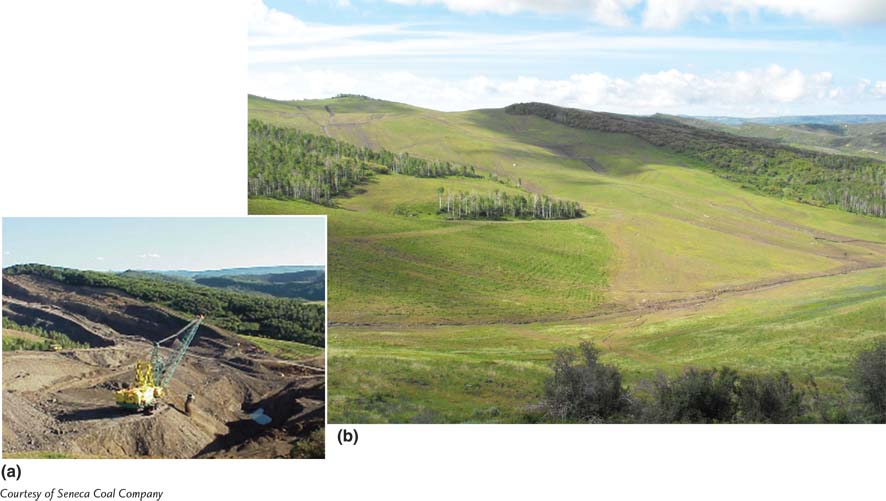working toward  sustainability
sustainability
Mine Reclamation and Biodiversity
One of the environmental impacts of surface mining is the amount of land surface it disturbs. Once a mining operation is finished, the mining company may try to restore it to its original condition. In the United States, the Surface Mining Control and Reclamation Act of 1977 requires coal mining companies to restore the lands they have mined. Regulations also require other types of mining operations to do some level of restoration.
A disturbed ecosystem can return to a state similar to its original condition only if the original physical, chemical, and biological properties of the land are re-
The mining company usually scrapes off the topsoil that was on the land and puts it aside at the beginning of the mining operation. This topsoil must be returned and spread over the landscape after mining is completed. Finally, the land must be replanted. In order to re-
Many former mining areas have not been reclaimed properly. However, there are an increasing number of reclamation efforts that have achieved conditions that equal those that existed prior to the mining operation. The Trapper Mine in Craig, Colorado, and other mines like it illustrate reclamation success stories.
The Trapper Mine produces about 2 million tons of coal per year that is sold to a nearby electricity generation plant. Although all coal mining operations are required to save excavated rock and topsoil, managers at the Trapper Mine have stated that they are meticulous about saving all the topsoil they remove. The rock they save is used to fill the lower portions of excavated holes. Workers then install drainage pipes and other devices to ensure proper drainage of water. The topsoil that has been set aside is spread over the top of the restored ground and contoured as it was before mining. Trapper Mine reclamation staff then replant the site with a variety of native species of grasses and shrubs, including the native sagebrush commonly found in the high plateaus of northwestern Colorado.
Government officials, and even the Colorado branch of the Sierra Club, have expressed approval of the Trapper Mine reclamation process. But perhaps the strongest evidence of its success is the wildlife that now inhabits the formerly mined areas. The Columbian sharp-

Reclamation issues must be addressed for each particular area where mining occurs. As we have seen, subsurface and surface water runoff in certain locations can contain high concentrations of toxic metals and acids. In other situations, although certain native species may increase in abundance after reclamation, other native species may decrease. Nevertheless, with supervision, skill, and enough money to pay for the proper reclamation techniques, a reclaimed mining area can become a satisfactory or even an improved habitat for many species.
Critical Thinking Questions
If you were on a committee asked to determine if a mine reclamation project had been successful, what three measures or conditions would you want to consider in your evaluation?
Identify two environmental problems that might occur in the area where you live if a mining site was not reclaimed.
References
Department of the Interior, Office of Surface Mining Reclamation and Enforcement. http:/
Raabe, S. 2002. Nature’s Comeback: Trapper Mine reclamation attracts wildlife, wins praise. Denver Post, November 12, p. C01.